Beans (Phaseolus)
Plant Health Problems
Diseases caused by Fungi:
Anthracnose, Colletotrichum lindemuthianum.
The disease appears on the leaves as a reddish-brown discoloration of the veins, particularly on the undersides of the leaves. The main damage is to the pods, where blackish-brown spots appear. These spots may have a pinkish ooze at their centers, and borders of red. The disease is usually found where growers have saved and planted their own seed since the fungus which causes this disease is carried in the seed.
The use of certified pathogen-free seed greatly reduces the potential for this disease. A two-year crop rotation schedule helps to reduce its prevalence.
Rust, Uromyces appendiculatus.
The common symptom of bean rust is a profusion of small (1-3 mm) reddish-brown raised lesions on the leaves. These pustules erupt after 6-10 days and release thousands of tiny reddish-brown spores. Sometimes larger pustules are surrounded by a yellow halo.
This disease causes minimal reduction in yield and in most cases does not pose a major problem.
White mold, Sclerotina sclerotiorum.
Dark, watery spots appear on the pods, stems, and leaves. The stems may be rotted through, causing the wilting and death of parts of the plant, or of the whole plant. Infected pods turn into a soft, watery mass. The pods touching the ground are most likely to rot. Very soon after the rot has begun, a white moldy fungus growth appears on the rotted areas. After a few days, hard, black kernels called sclerotia may be found in the drying fungus mass. The fungus carries over as these sclerotia, which are resistant to drying and temperature changes. The fungus may persist as sclerotia in soil for at least ten years. The white mold fungus also causes drop rot of lettuce.
The best method to avoid white mold is to practice crop rotation, and not to plant beans on an old lettuce field.
Damping-off, Pythium debaryanum, Rhizoctonia solani.
The base of the stem appears tough and discolored, usually reddish-brown. This fungus disease is sometimes severe enough to kill young plants.
Planting of seed treated with fungicide will reduce losses from this disease.
Downy mildew, Phytophthora phaseoli.
Pods of lima beans may show this fungus disease as white, downy, felt-like mold. Very often the fungus will distort the young leaves and flowers, which are also covered with the downy mold.
The disease breaks out only during very wet growing seasons so that fungicide sprays are usually not required for lima beans.
Diseases caused by Bacteria:
Bacterial blight, Xanthomonas phaseoli.
Small wet spots appear on the leaves. These spots may or may not have yellow borders. Severe infection will kill the young plant. The pod symptoms are dark green, wet-looking blotches, sometimes having red borders. Common bacterial blight occurs when contaminated seeds are planted, when plantings are made in fields with a history of the disease, and when the climate is consistently hot and humid. Bacterial blight is spread rapidly by driving rain or hail.
If there is an outbreak, keep out of the field when the plants are wet with rain or dew. The use of certified pathogen-free seed and a two-year crop rotation schedule helps to reduce the prevalence of this disease.
Diseases caused by Viruses:
Mosaic.
Injury by this virus appears on the leaves as a regular light and dark mottling. The pattern may be yellow and green. The disease is usually restricted to a few plants in any one field. Aphids carry the virus from plant to plant. The virus is also present in alfalfa and clover; therefore, avoid planting beans next to fields of alfalfa or clover.
There is no control for this disease, however, in a small planting the timely removal of infected plants may slow its spread.
Diseases caused by Physiological/Environmental Factors:
Sun scorch.
The leaves look withered and burned. This sometimes happens when a few hot, dry days follow a period of cool, cloudy weather.
Ozone damage.
The leaves take on a mottled bronze appearance with tiny necrotic flecks. The cause is air pollution. Exhaust gases from internal combustion engines become trapped by a temperature inversion during hot, still humid days.
Plants recover when air quality improves.
Insect Problems
Bean aphid, Aphis fabae.
This black aphid occasionally occurs on green and snap beans but is more apt to infest broad beans. There are many generations each year. Eggs are laid in the autumn. They overwinter on various shrubs. For more detail and control measures, see the Aphid fact sheet.
Bean leaf beetle, Cerotoma trifurcata.
The adults feed on the underside of the leaves and on the stems of seedlings. The slender white larvae feed on the roots and stem below the soil surface. The adults vary greatly in color and markings but are typically reddish to buff in color with a black band around the outer wing margin and three or four black spots along the inner edge. They are about 1/4" long and overwinter as adults. Control has not been generally needed.
Bean weevil, Acanthoscelides obtectus.
The beetle is about 1/8" long, brown, with wingcovers striped lengthwise with light brown and gray and mottled with darker spots. The adult lays eggs in the pods in the field. The larvae feed inside the seeds or beans and emerge after the beans have been placed in storage. They will continue to breed in the dried seeds and render them unfit for food or for planting. There are several generations a year. Beans dried for seed or for eating can be protected by heating for one hour at 120º F.
Cutworms.
These larvae often damage bean seedlings. See fact sheet.
European corn borer, Ostrinia nubilalis.
The larvae sometimes bore in the stems and pods of beans. This insect feeds not only on corn, but on other crop plants (including potatoes, peppers, and beans), many weeds, and on a variety of other herbaceous plants. The larvae tunnel in the stalk and ears in all directions, weakening the stalks so that they break over. The larva is pale white or gray with black tubercles and is not more than an inch in length when fully grown. Adults have a wing spread of an inch or so and are buff to brown in color. There are usually two generations annually. Eggs are laid on the underside of leaves, and the larvae tunnel in the stalks and pupate in the burrows. Second generation larvae and those of the single generation corn borer overwinter in the stalks and pupate in the spring.
Control begins with tillage of the corn stubble, either in the fall or early in the spring. This reduces the survival of borers from the previous year. Pheromone traps may be used to monitor flight of the adults. Then, from the time the tip of the tassel first becomes visible, looking down into the whorl of leaves, until it emerges, watch carefully for larvae or signs of larval damage. Among the compounds registered for control of this pest in Connecticut are Bt formulations. Bacillus thuringiensis var. kurstaki (Bt), in either a granular or liquid formulation, may be applied to the top of the plant so that it flows down into the center of the whorl. Additional applications may be needed when caterpillars or signs of feeding damage are visible, or when pheromone traps indicate the flight of adults. As the ear develops, applications should be directed to the ear zone of the plant. Consult the label for dosage rates, safety precautions, and preharvest intervals.
The parasitic wasp Trichogramma has been used as alternative method of control. This tiny wasp attacks the egg masses of the corn borer, and the eggs of other caterpillars, too. Be sure to purchase the insects from a reputable supplier and make sure the strain you purchase is known to be well adapted to attacking corn borer on corn. Bt will not harm the Trichogramma wasps, but other insecticides will.
Green cloverworm, Plathypena scabra.
In some years, bean plants may be injured by inch long green wiggling caterpillars that riddle the leaves. Control is not often necessary.
Green stink bug, Acrosternum hilare.
This bug is from 1/2 to 3/4" long, oval in shape, and bright green with yellow or reddish margins. This bug occasionally injures beans and various other plants by sucking sap from the shoots and leaves. Control measures have not been necessary against this insect.
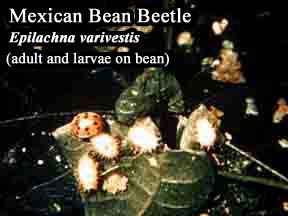 Mexican bean beetle, Epilachna varivestis.
Mexican bean beetle, Epilachna varivestis.
This is the most destructive of all insects feeding on beans in Connecticut. Both larvae and adults feed on leaves during the entire season. See fact sheet.
Potato flea beetle, Epitrix cucumeris.
This flea beetle may sometimes feed on beans. This is a small, black, jumping flea beetle that feeds upon the leaves of potato, tomato, tobacco, and many other plants, eating out small round holes from the underside, but leaving the upper epidermis. The remaining tissue soon dies, however, and falls away, leaving holes. This beetle is not much more than 1/16" long. It lives through the winter under rubbish and in other sheltered places, and may first be found in the spring on plantain and other weeds, sometimes also on the leaves of apple, wild cherry, and maple. As soon as the preferred food such as potato and tomato plants appear in the garden or field, the flea beetles gather upon them. The overwintering beetles lay eggs in the soil in June. The larvae feed upon tubers and roots of the host plants. An abnormal growth sometimes takes place around each injury, causing scurfy and pimply potatoes. The larvae transform and beetles emerge early in July.
These beetles feed on the potato foliage as long as the plants are green and temperatures are favorable. These insects then hibernate until the following spring. If the flea beetles are controlled in the spring when they first begin feeding, fewer beetles will be present in the fall and the following spring. See Flea Beetle fact sheet.
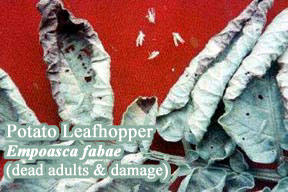 Potato leafhopper, Empoasca fabae.
Potato leafhopper, Empoasca fabae.
This insect is a pest of beans in some years in Connecticut. It does not overwinter here, and the severity of infestation depends on the size of the migrating population and the weather. The adult is about 1/8" long and yellowish green. Nymphs are similar in color but have no wings. Both adults and nymphs are difficult to see because they move rapidly. Adults and nymphs cause injury by sucking sap from the bottom side of leaves. This causes the young leaves to curl or gives them a white peppered appearance. Continued feeding results in a yellowing or browning of the leaves, called "hopperburn." Among the compounds registered to control this pest in Connecticut are pyrethrum, rotenone, malathion, or carbaryl. Consult the label for dosage rates, safety precautions, and preharvest intervals.
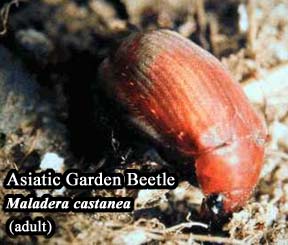 Scarab beetles.
Scarab beetles.
Scarab beetles, such as the Japanese beetle and Asiatic garden beetle, are occasionally pests of beans, particularly in home gardens where these insects are abundant in nearby lawns. Adult Japanese beetles, Popillia japonica, have copper colored wings and a metallic green head and thorax. Adults are major pests due to their feeding on rose flowers and the foliage of many plants, including grape and beans. Japanese beetle traps containing floral and sex attractant lures are readily available at home and garden centers. These traps may help reduce the overall number of beetles. However, beetles often land and feed on plants close to traps, so traps should be placed well away from valued plantings. The Asiatic garden beetle is about 3/4" long, velvety cinnamon brown with a faint iridescence. Adults feed at night on many kinds of plants, especially aster, barberry, bean, cherry, chrysanthemum, currant, dahlia, geranium, catalpa, seedling conifers, rhododendrons and strawberries. Flying beetles are attracted to lights at night. During the day, the beetles, which hide in the soil around the plants, are seldom seen unless one knows where to find them. The larvae of the Asiatic and Japanese beetles are pests of lawn grass in most areas of the state. Eggs are laid in the grass during July. The larvae feed on grass roots until cold weather, when they burrow down in the ground to overwinter. Feeding resumes after larvae resurface in the spring. Treating the lawns with insecticides usually gives effective control, and will reduce the number of adults feeding on other plants.
Seedcorn maggot, Delia platura.
Small grayish-brown flies lay eggs in newly plowed fields, and the dirty yellowish-white maggots that develop attack the seeds of bean and other vegetables, injuring or destroying them in the ground so that they do not produce good plants. Damage is much greater in cold, wet weather in soils with high organic matter. Turning in a cover crop just before planting also increases the damage. These maggots can be controlled by delaying planting until the weather is warm enough and new organic matter added to the soil has adequately decomposed. Once the damage has been recognized, it is too late for effective control.
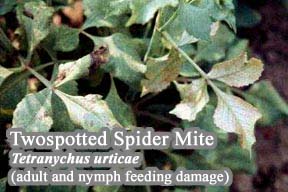 Twospotted spider mite, Tetranychus urticae.
Twospotted spider mite, Tetranychus urticae.
This mite, which is about 1/16" long when mature, lives on the underside of leaves where it sucks plant sap. The leaves of infested plants have a sickly appearance, with yellow or reddish-brown blotches. Webbing may be visible in heavy infestations. Injury is most severe in hot, dry weather. Natural enemies normally regulate the population as long as pesticide use is avoided, so control is not usually necessary.
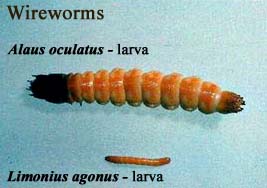 Wireworms.
Wireworms.
Seeds and underground stems of young plants may be attacked by several species of hard, smooth, shiny dark brown wireworms about one inch long. These shiny, hard-skinned, wire-like larvae are the immatures of click beetles (Elateridae). Wireworms feed on seeds, roots, and stems, producing weak plants. Several species of wireworms are involved and, like the white grubs, are more injurious to crops planted on soil which is the first or second year out of sod. The corn wireworm, Melanotus communis, or the wheat wireworm, Agriotes mancus, usually occur in heavier organic soils and tend to disappear with continued cultivation. Light sandy soils favor the eastern field wireworm, Limonius agonus. Continued cultivation encourages this species. The presence of wireworms in soil may be detected with baits, such as a cut potato, a mixture of untreated wheat and corn seeds, or rolled oats, buried a few inches deep in the soil, marked with a flag, then dug up 2-3 weeks later. If present in large numbers, they may also be visible when the soil is turned over.
Wireworms are difficult to control with available insecticides. Some tactics which may reduce damage are: 1) delay planting for several weeks after plowing so that little food is available, 2) use plastic mulch between rows to heat the soil above the wireworms' preferred temperature, and 3) rotate wireworm-susceptible crops with plants in the cabbage family (including canola or mustard used as a cover crop) and then incorporate plant residues.

